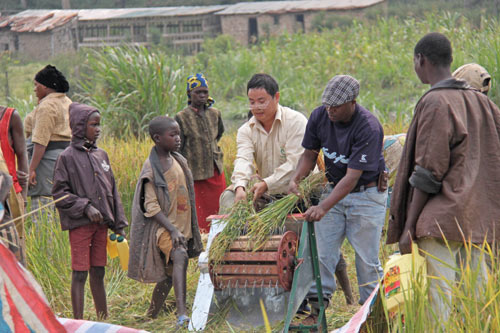Planting the seeds of growth
Updated: 2012-12-18 15:22Chinese agricultural scientists show the way toward sustainable agriculture in Rwanda
According to ancient Rwandan folklore, eating mushrooms would lead to the death of cows, a symbol of wealth in Rwandan culture. Such was the taboo against mushrooms, that despite being rich in nutrients and having immense health benefit, it did not find a place in the Rwandan cuisine dominated by staples like cassava, corn and potato.
With such a stigma against it, Rwanda would be the last place where one would expect mushroom cultivation to be a lifeline for farmers.
Not only have times changed, but also culinary habits. The once-shunned mushroom is now a much sought after ingredient in Rwanda for soups, salads, and sandwiches among other things.
|
 |
|
A Chinese expert demonstrates agricultural machinery in Rwanda. PROVIDED TO CHINA DAILY |
Though the mushroom acceptance was triggered by several factors, its genesis can be traced to the pioneering efforts made in Rwanda by a group of Chinese agricultural scientists from Fujian Agriculture and Forestry University.
"Changing the local dietary practices was an extremely challenging task as we had to overcome hurdles like tradition and culture. But we were lucky in our efforts, and many of the Rwandese have realized that mushrooms are an environment-friendly, high-profit and nutritional industry," says Lin Yingxing, head of the China-Rwanda Agriculture Technology Demonstration Center.
Lin, a professor from the Fujian university, is also a well-known expert on edible fungus technology or juncao (literally meaning fungus grass).
"Our technology focuses on improving the fertilizer ingredients needed for mushroom cultivation. We mainly use withered grass and residue from other agricultural activities to grow mushrooms," he says.
"This is a more sustainable and environmentally friendly practice, unlike conventional techniques that are reliant mostly on wood."
Lin and his team of agricultural experts and researchers from the Fujian university set up the C-RATDC in April 2011 and have been working at the center since then. The center is one of the 14 such facilities that China agreed to set up for reinforcing economic aid to Africa during the Beijing Summit of the China-Africa Cooperation Forum in 2006.
Located at Rubona in Butare of Huye district of Southern Province in Rwanda, the sprawling facility encompasses classrooms, production facilities, demonstration workshops and staff quarters.
Introducing mushrooms to Rwanda was a plan that was formulated after evaluating the success achieved by similar programs in other nations, Lin says.
"Our first overseas juncao mushroom cooperation project was in Papua New Guinea in 1995," Lin says. "Later on we set up similar projects in Lesotho, South Africa and some other African countries."
The biggest advantage of growing mushrooms is that it is a low-cost process that gives quick returns, he says.
"To popularize mushroom cultivation in Rwanda, we decided to focus and support women's associations, orphanages and nursing homes for the aged as we felt it would give them a safe and easy way to earn their livelihood," Lin says, adding that young college graduates who are eager to start their own business are now among his frequent visitors.
Bakayihinda Marthe, president of the Cooperative Abartuhuje Ngoma, a women's association, whose members are mostly widows from the genocide in 1994, says the innovation and knowledge provided by the Chinese experts have proved to be extremely valuable.
"This is really an affordable and simple business and gives us steady returns," she says. "We have learned that mushrooms can play a big role in improving the overall nutrition levels of our people."
- BYD exports three electric cars to Thailand
- Grid gets first jolt of residential solar power
- US now largest buyer of China's exports
- China's outbound M&As on the rise
- Tobacco control may entail price, tax rises
- Quanzhou becomes pilot financial reform zone
- New automobiles shine at Geneva Motor Show
- World's longest high-speed rail 'on track'
- Jiugui Liquor involved in plasticizer scandal again
- Accident reignites school bus safety concerns
- China to revise labor law
- Trademark registration under scrutiny
- Dinner ban takes toll on liquor firms
- CIC tables bid for London's Chiswick Park
- Property buyers eye overseas market
- Call for law to protect personal information
- China to cut train ticket prices
- Christmas business
- Solar industry to get jolt from new policies
- KFC chicken under spotlight















